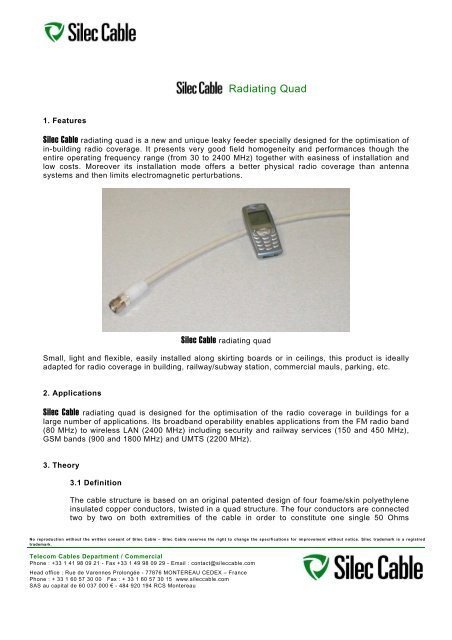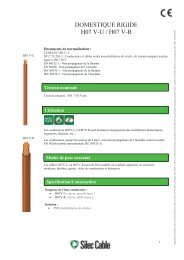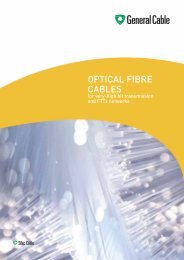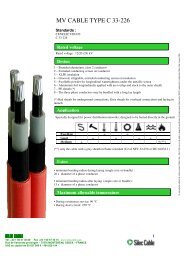Guide QR Silec GB 3 - Silec Cable
Guide QR Silec GB 3 - Silec Cable
Guide QR Silec GB 3 - Silec Cable
Create successful ePaper yourself
Turn your PDF publications into a flip-book with our unique Google optimized e-Paper software.
1. Features<br />
No reproduction without the written consent of <strong>Silec</strong> <strong>Cable</strong> – <strong>Silec</strong> <strong>Cable</strong> reserves the right to change the specifications for improvement without notice. <strong>Silec</strong> trademark is a registred<br />
trademark.<br />
Telecom <strong>Cable</strong>s Department / Commercial<br />
Phone : +33 1 41 98 09 21 - Fax +33 1 49 98 09 29 - Email : contact@sileccable.com<br />
Head office : Rue de Varennes Prolongée - 77876 MONTEREAU CEDEX – France<br />
Phone : + 33 1 60 57 30 00 Fax : + 33 1 60 57 30 15 www.sileccable.com<br />
SAS au capital de 60 037 000 € - 484 920 194 RCS Montereau<br />
Radiating Quad<br />
<strong>Silec</strong> <strong>Cable</strong> radiating quad is a new and unique leaky feeder specially designed for the optimisation of<br />
in-building radio coverage. It presents very good field homogeneity and performances though the<br />
entire operating frequency range (from 30 to 2400 MHz) together with easiness of installation and<br />
low costs. Moreover its installation mode offers a better physical radio coverage than antenna<br />
systems and then limits electromagnetic perturbations.<br />
<strong>Silec</strong> <strong>Cable</strong> radiating quad<br />
Small, light and flexible, easily installed along skirting boards or in ceilings, this product is ideally<br />
adapted for radio coverage in building, railway/subway station, commercial mauls, parking, etc.<br />
2. Applications<br />
<strong>Silec</strong> <strong>Cable</strong> radiating quad is designed for the optimisation of the radio coverage in buildings for a<br />
large number of applications. Its broadband operability enables applications from the FM radio band<br />
(80 MHz) to wireless LAN (2400 MHz) including security and railway services (150 and 450 MHz),<br />
GSM bands (900 and 1800 MHz) and UMTS (2200 MHz).<br />
3. Theory<br />
3.1 Definition<br />
The cable structure is based on an original patented design of four foame/skin polyethylene<br />
insulated copper conductors, twisted in a quad structure. The four conductors are connected<br />
two by two on both extremities of the cable in order to constitute one single 50 Ohms
composite circuit on which the electromagnetic wave propagates as quasi-TEM mode (same<br />
mode of propagation than coaxial cables).<br />
The conversion of part of that propagating mode energy into a common radiating mode<br />
depends on the circuit unbalance. A tight control of this parameter is obtained by cable<br />
construction (i.e. twisting pitch of the cable).<br />
A very good field homogeneity and performances through the entire frequency range (from<br />
30 up to 2400 MHz) are obtained by two antagonist phenomena :<br />
- At low frequencies, the common mode radiates more than at high frequencies<br />
- At high frequencies, the radiating waves are more confined around the cable than at low<br />
frequencies, but the circuit unbalance increases leading to better radiating behaviour.<br />
Note :<br />
The physical phenomena involved are totally reversible implying that the cable operates as<br />
well as an emitting distributed antenna than as receiving distributed antenna.<br />
3.2 Characteristics<br />
The main electrical characteristics of the <strong>Silec</strong> <strong>Cable</strong> radiating quad are its longitudinal loss<br />
and its coupling loss. Of course the kind of installation and the surrounding near the cable<br />
(presence of metallic conductors) can affect the radiated field along the cable and then its<br />
electromagnetic field properties.<br />
3.2.1 Longitudinal loss<br />
Like all cables, the <strong>Silec</strong> <strong>Cable</strong> radiating quad attenuates the signal travelling inside in<br />
function of the frequency. The longitudinal attenuation is mainly influenced by the<br />
type of dielectric and the size of the cable.<br />
For radiating cables, the surrounding of the cable has an influence on the<br />
longitudinal loss, because a part of the emitted electromagnetic field can be<br />
absorbed by the cable again. The longitudinal loss depends also from the cable<br />
structure (twisting pitch).<br />
3.2.2 Coupling loss<br />
The coupling of energy out of the cable, to the outer space to a receiving antenna, is<br />
described by the coupling loss. This coupling loss is defined as the ratio of the<br />
received power antenna, at a certain distance, to the power in the cable. Because of<br />
the reciprocity, similar considerations are valid for the transmission from antenna into<br />
the cable.<br />
The coupling loss depends from the structure of the cable as well as interferences<br />
and reflections of the cable surrounding. Due to these latter, the coupling loss is<br />
generally characterised by two coverage types :<br />
- The mean value (c50) is the coupling loss with 50 % probability : 50 % of the<br />
local values are smaller than this specific value,<br />
- The 95 % coverage value (c95) : 95 % of the local values are lower than c95.<br />
Mostly, the 95 % coverage (c95) is used to characterise digital communications.<br />
3.2.3 System loss<br />
The system loss represents the maximum loss authorised between the emitter and<br />
the receiver without interruption of communication. The system loss determines then<br />
the maximum length of a link without amplifier. This latter depends on :<br />
- The system dynamic range (emeitting and receiving sensibility),<br />
- The system frequency.<br />
No reproduction without the written consent of <strong>Silec</strong> <strong>Cable</strong> – <strong>Silec</strong> <strong>Cable</strong> reserves the right to change the specifications for improvement without notice. <strong>Silec</strong> trademark is a registred<br />
trademark.<br />
Telecom <strong>Cable</strong>s Department / Commercial<br />
Phone : +33 1 41 98 09 21 - Fax +33 1 49 98 09 29 - Email : contact@sileccable.com<br />
Head office : Rue de Varennes Prolongée - 77876 MONTEREAU CEDEX – France<br />
Phone : + 33 1 60 57 30 00 Fax : + 33 1 60 57 30 15 www.sileccable.com<br />
SAS au capital de 60 037 000 € - 484 920 194 RCS Montereau
4. Performances<br />
For instance, at 900 MHZ, 95 % of the total losses are below 100 dB for a link of 80<br />
meters (see next paragraph).<br />
The following tables summarize the performances of the sample of the <strong>Silec</strong> <strong>Cable</strong> radiating quad<br />
depending on different operating frequencies and system losses.<br />
4.1 Main transmission performances<br />
Frequency<br />
(MHz)<br />
Longitudinal loss<br />
(dB/100 m)<br />
Coupling loss<br />
50 %<br />
No reproduction without the written consent of <strong>Silec</strong> <strong>Cable</strong> – <strong>Silec</strong> <strong>Cable</strong> reserves the right to change the specifications for improvement without notice. <strong>Silec</strong> trademark is a registred<br />
trademark.<br />
Telecom <strong>Cable</strong>s Department / Commercial<br />
Phone : +33 1 41 98 09 21 - Fax +33 1 49 98 09 29 - Email : contact@sileccable.com<br />
Head office : Rue de Varennes Prolongée - 77876 MONTEREAU CEDEX – France<br />
Phone : + 33 1 60 57 30 00 Fax : + 33 1 60 57 30 15 www.sileccable.com<br />
SAS au capital de 60 037 000 € - 484 920 194 RCS Montereau<br />
Coupling loss<br />
95 %<br />
Applications<br />
150 -15,4 -53,5 -63,3 Security services<br />
450 -25,1 -64,0 -75,3<br />
Security and railway<br />
services<br />
900 -35,4 -68,0 -71,7 GSM<br />
1800 -71,2 -56,2 -68,4 GSM<br />
2200 -76,0 -58,7 -71,7 UMTS<br />
2400 -77,0 -60,3 -74,2 Wireless LAN<br />
Coupling loss @ 2 m according to IEC 1196-4.<br />
Note :<br />
The coupling loss values represent the average of coupling losses measured with<br />
orthogonal, radial and axial polarisation antennas.<br />
4.2 System performances<br />
Frequency<br />
(MHz)<br />
Achievable cable length<br />
(m) with coupling loss 95 %<br />
and system loss 100 dB<br />
Achievable cable length<br />
(m) with coupling loss 95 %<br />
and system loss 120 dB<br />
Applications<br />
150 238 368 Security services<br />
450 98 178<br />
Security and railway<br />
services<br />
900 80 137 GSM<br />
1800 44 73 GSM<br />
2200 37 64 UMTS<br />
2400 34 59 Wireless LAN<br />
Coupling loss @ 2 m according to IEC 1196-4.<br />
Note : These measurements characterise only the sample supplied.
5. System structures<br />
The <strong>Silec</strong> <strong>Cable</strong> radiating quad is designed to support a large number of applications. Therefore<br />
different network architectures are possible.<br />
For GSM and UMTS applications, the <strong>Silec</strong> <strong>Cable</strong> radiating quad could be linked with a pico-repeater.<br />
This latter aims at receiving the outside GSM signal, amplifying it again and then emetting it indoors<br />
where the electromagnetic signal is too weak. In this case, the radiating quad could be directly<br />
connected to a pico-repeater .<br />
For WiFi applications, the <strong>Silec</strong> <strong>Cable</strong> radiating quad could be linked with an access point. This latter<br />
aims at linking a local area network with a wireless local area network. In this case, each cable<br />
length could be connected to an access point (one extremity to the access point and the second<br />
one to a load) and each access point connected to one of RJ45 sockets of the local area network.<br />
6. <strong>Silec</strong> <strong>Cable</strong> offer<br />
The <strong>Silec</strong> <strong>Cable</strong> radiating quad can be delivered :<br />
- <strong>Cable</strong>s on drums and connectors to be fitted on site,<br />
- Standard lengths of 30, 50 or 100 m equipped with connectors.<br />
A specific connector fitted to the <strong>Silec</strong> <strong>Cable</strong> radiating quad is available. This connector proposes a<br />
mechanical fixing with the cable in order to fit easily to installation lengths.<br />
No reproduction without the written consent of <strong>Silec</strong> <strong>Cable</strong> – <strong>Silec</strong> <strong>Cable</strong> reserves the right to change the specifications for improvement without notice. <strong>Silec</strong> trademark is a registred<br />
trademark.<br />
Telecom <strong>Cable</strong>s Department / Commercial<br />
Phone : +33 1 41 98 09 21 - Fax +33 1 49 98 09 29 - Email : contact@sileccable.com<br />
Head office : Rue de Varennes Prolongée - 77876 MONTEREAU CEDEX – France<br />
Phone : + 33 1 60 57 30 00 Fax : + 33 1 60 57 30 15 www.sileccable.com<br />
SAS au capital de 60 037 000 € - 484 920 194 RCS Montereau





